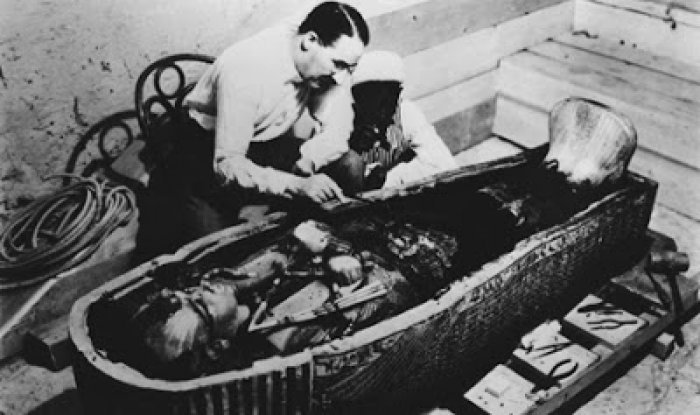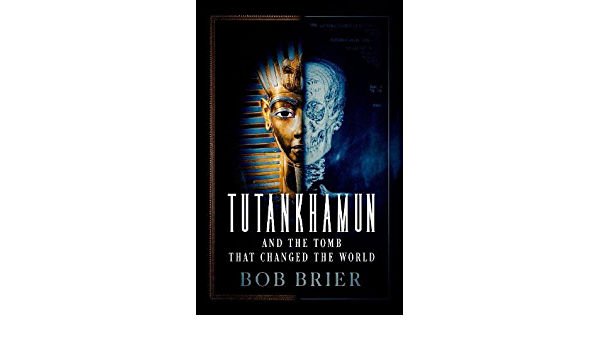Jan Bartek – AncientPages.com – The discovery of King Tutankhamun’s tomb in 1922 was an archaeological sensation. When British archaeologist Howard Carter found King Tut’s tomb in Luxor’s Valley of the Kings it was intact and packed with antiquities, including Tutankhamun’s world-famous golden mask.

Howard Carter entered King Tutankhamen’s burial chamber and found a series of coffins that contained the teen king’s mummified body. Public domain
Bob Brier, a leading Egyptologist at Long Island University, has now presented evidence Howard Carter stole precious treasures from Pharaoh Tutankhamun’s tomb. It has long been rumored that Carter had taken treasures from the excavation, but solid evidence was missing.
“An accusation that Carter handled property “undoubtedly stolen from the tomb” has emerged in a previously unpublished letter sent to him in 1934 by an eminent British scholar within his own excavation team.
It was written by Sir Alan Gardiner, a leading philologist. Carter had enlisted Gardiner to translate hieroglyphs found in the 3,300-year-old tomb, and later gave him a “whm amulet”, used for offerings to the ᴅᴇᴀᴅ, ᴀssuring him that it had not come from the tomb.
Gardiner showed the amulet to Rex Engelbach, the then British director of the Egyptian Museum in Cairo, and was dismayed to be told that it had indeed come from the tomb as it matched other examples – all made from the same mould.
Firing off a letter to Carter, he enclosed Engelbach’s damning verdict, which reads: “The whm amulet you showed me has been undoubtedly stolen from the tomb of Tutankhamun.”
Gardiner told Carter: “I deeply regret having been placed in so awkward a position.”
But he added: “I naturally did not tell Engelbach that I obtained the amulet from you.”
The letters, now in a private collection, will be published in a forthcoming book from Oxford University Press, Tutankhamun and the Tomb that Changed the World

It is often thought that the story of Tutankhamun ended when the thousands of dazzling items discovered by Howard Carter and Lord Carnarvon were transported to the Egyptian Museum in Cairo and put on display. But there is far more to the boy-king’s story. Tutankhamun and the Tomb that Changed the World explores the 100 years of research on Tutankhamun that have taken place since the tomb’s discovery, from the several objects in the tomb made of meteoritic iron that came from outer space to new evidence that shows that Tutankhamun may actually have been a warrior who went into battle. Author Bob Brier also takes readers behind the scenes of the recent CT-scans of Tutankhamun’s mummy to reveal more secrets of the young pharaoh.
The book also illustrates the wide-ranging impact the discovery of Tutankhamun’s tomb had on fields beyond Egyptology. Brier examines how the discovery of the tomb influenced Egyptian politics and contributed to the downfall of colonialism in Egypt. Outside Egypt, the modern blockbuster exhibitions that raise great sums of monies for museums around the world all began with Tutankhamun, as did the idea of documenting every object discovered in place before it was moved. And to a great extent, the modern fascination with ancient Egypt DL Egyptomania DL was also greatly promoted by the Tutmania that surrounded the discovery of the tomb. Deeply informed by the latest research and presented in vivid detail, Tutankhamun and the Tomb that Changed the World is a compelling introduction to the world’s greatest archaeological discovery. Read more
Its author, Bob Brier, a leading Egyptologist at Long Island University, told the Observer that suspicions about Carter helping himself to treasures have long been rumoured: “But now there’s no doubt about it,” the Guardian reports.
After the discovery of King Tut’s tomb, Carter supervised the transportation of the ancient artifacts to be displayed in the Egyptian Museum. At the time, some Egypotlogists were suspicious of Carter and his claim that the tomb’s treasures had been looted in antique times.
In 1947, in an obscure scientific journal in Cairo, Alfred Lucas, one of Carter’s employees, reported that Carter secretly broke open the door to the burial chamber himself before appearing to reseal it and cover the opening.
“They were suspected of having broken into the tomb before its official opening, taking out artefacts, including jewellery, sold after their respective deaths. It’s been known that Carter somehow had items, and people have suspected that he might have helped himself, but these letters are ᴅᴇᴀᴅ proof,” Brier said.
“He certainly never admitted it. We don’t have any official denial. But he was locked out of the tomb for a while by the Egyptian government. There was a lot of bad feeling, and they thought he was stealing things.”
Egyptian authorities were unable to prove Carter had been stealing treasures. In his book, Brier writes that Carter had been planning to steal a wooden head of Tutankhamun found in his possession: “The Egyptian authorities had entered and inspected Tomb No. 4, which Carter and the team had used for storage of antiquities, and discovered a beautiful lifesize wooden head of Tutankhamun as a youth.

Inside Pharaoh Tutankhamun’s tomb, 18th dynasty. Credit: EditorfromMars – CC BY-SA 4.0
“It had been packed in a Fortnum & Mason crate, but it had never been mentioned in Carter’s records of the finds, nor in the volume describing the contents of the antechamber…. Carter argued that it had simply been discovered in the rubble in the descending pᴀssage.”
Brier said: “Later, we do find objects on the Egyptian antiquities market from his estate that clearly came from the tomb.”
See also: More Archaeology News
As reported by the Guardian, “in his 1992 book on Carter, the late Harry James drew on Carter letters in the Griffith Insтιтute at the University of Oxford, which refer to a row with Gardiner that led to an amulet’s return to Cairo.
The significance of the previously unpublished correspondence is that the accusation came from a leading expert who was actually involved in the first excavation.”
Written by Jan Bartek – AncientPages.com Staff Writer





